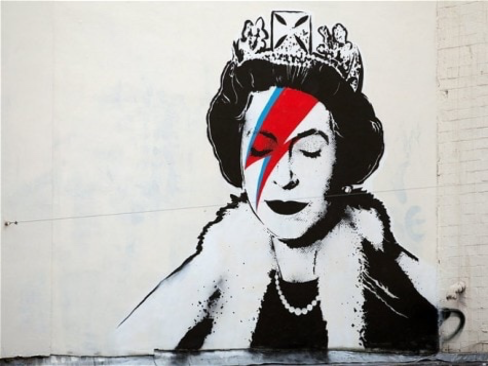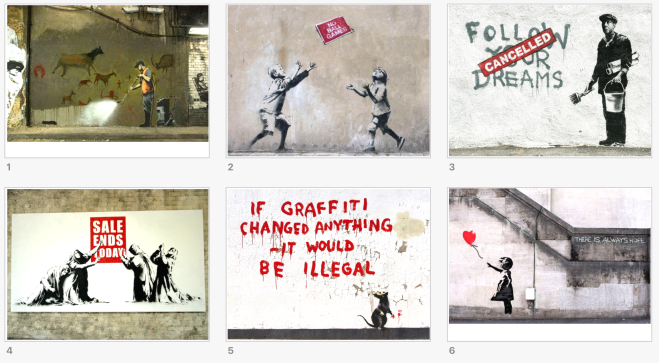This is easily one of the most engaging lessons I’ve ever taught. So far, I’ve used it with over 100 different students across a range of ages and classes, and it just works. As if that wasn’t enough, it also leads quite naturally into FCE and CAE writing projects (lesson plans coming soon). All in all, it’s a great way to get your students into modern British art, while also encouraging deeper reflection and critical thinking.
NOTE: Originally, this lesson was just a riff on a double-page spread from the Speak Out Upper Intermediate course. Eventually, I developed it to the point that I was no longer using the materials from the coursebook. However, I’m still very grateful to both Frances Eales and Steven Oakes for the fantastic idea!
Level: B2 to C1 (Upper-Intermediate to Advanced)
Age: teenagers or adults
Time: 60 minutes
Materials: vocabulary cards, slideshow of artwork by Banksy (comment for files)
Aims:
- By the end of the lesson, students will be better able to use the following lexis to praise/criticise Banksy’s art: irresponsible, satirical; vandalism, a valid art form; controversial; provocative; anarchy-lite; defaces buildings; derivative; hideous; pioneering; iconic; subversive, distinctive.
Procedure
1. Speaking: Tell students that they’re going to look at some famous artwork. In pairs, they should discuss the following two questions: What do you think of this piece of art? Why do you think the artist painted this picture? Show students slide #1:
2. Feedback: Do this as a whole-class activity. Depending on what your students are like, you might not have to do any work at all here. If they’re struggling to interpret the work, guide the discussion by asking them: Who can you see in the picture? Does she still look like that now? Why has the artist chosen to depict her as a young woman? What could the lightning bolt represent? Why combine iconic images of the Queen and David Bowie in this way? What moral or message could be behind the picture? What kind of person do you think the artist is? What are his beliefs? Encourage them to think as critically as possible!
3. Vocabulary: Tell students you’re going to give them some useful vocabulary, written on cards. (If you don’t have time to prepare these, just dictate the word list.) Working in small groups, ask them to sort the cards into two categories: I’m confident about this word/phrase vs I’m not confident about this word/phrase.
4. Feedback: Students can peer-check any new or difficult words/phrases with the rest of the class, or using dictionaries and translation tools. Give teacher-led explanations only when students really need it, e.g. perhaps with anarchy-lite or pioneering, where they might need a few more examples to get the idea.
5. Speaking: Tell students they’re going to look at some more work by the same artist. In pairs, they should discuss the same two questions (What do you think of this piece of art? Why do you think the artist painted this picture?), using the new vocabulary to help them. Now show them slides #2-#7, spending 45-60 seconds on each picture.

6. Feedback: Based on your monitoring during the previous activity, you might have some useful feedback to give here in terms of grammar, vocabulary, pronunciation or speaking strategies. If not, skip this stage!
7. Response: In pairs, students choose their favourite and/or least favourite picture from the slides. Use this as a starting point for a large-group or even whole-class chat. The discussion that naturally emerges at this stage is always fascinating and completely different for each class, but here are some examples of questions I heard during this stage: Why has Banksy chosen to stay anonymous? Should graffiti be legalised? Would Banksy want graffiti to be legalised? What would have to happen for Banksy to consider his art a success? To what extent does his work encourage vandalism? To what extent does it cheapen the work of other contemporary artists? Who gets to decide what is art and what is not? What would happen if Banksy painted a mural in your town/city?
That’s all for now! Below, I’ve included three of my #ELTwhiteboards so you can see all the different directions this lesson could take. Let me know where yours goes!




Hello Sanchia,
Your lesson seems interesting to do and from what you are saying the students have fun doing it! Would it be possible to have the material for part1 and 2?
Thank you so much,
Johanna
simon.johanna76@gmail.com
LikeLike
Thanks Johanna! I’ve just sent you the material. Let me know how the lesson goes!
LikeLike
Hi Sanchia,
I would love to share this with my Grade 8 students here in Toronto, Canada.
Here is my email: asangha5@uwo.ca
Thank you in advance!
LikeLike
Sorry I took so long to get back to you! I’ve just sent the materials over. Let me know how the lesson goes.
LikeLike
Hi, Sanchia,
I think this lesson on Bansky is great. I was wondering if you could send me the materials for part 1 and 2.
Thanks.
Nuria
LikeLike
Yes, of course! What’s your email address?
LikeLike
Hi there! What a fantastic lesson idea! Do you mind passing me the vocabulary cards and all the material necessary?
Thanks a lot!
LikeLike
Hi Dorota! Of course I can. What’s your email address?
LikeLike
Hi Sanchia! This is a great idea for a class. Could I get the material please?
LikeLike
Sure, Sarah – can I have your email address so I can send it to you?
LikeLike
Hi Sanchia! Please can you share your resources with me. I’d love to use this with my C1 group!
LikeLike
Of course – leave me your email and I’ll send them over to you!
LikeLike
Hi Sanchia! I love the lesson! Would it be possible to have the materials / lesson plan? Thanks and keep up the good work! Rachel
LikeLike
Of course! What’s your email address? I’ll send them over.
LikeLike
Great! It’s rachel.gomez.queijeiro@gmail.com .
Once again, thanks & keep up the great work!
LikeLike